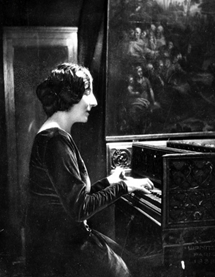Landowska Wanda

Wanda Landowska (* July 5, 1879 Warsaw- † August 16, 1959 Lekeville, CT, USA) pianist, harpsichordist, composer. She studied piano with Jan Kleczyński and Aleksander Michałowski at the Conservatory in Warsaw. In Berlin, she studied the secrets of composition in the class of Heinrich Urban, who also studied with Ignacy Jan Paderewski and Mieczysław Karłowicz. From 1900 she moved to Paris, where she devoted herself to the music of the 17th and 18th centuries. Over time, the artist’s interest is focused on the interpretation of works by J. S Bach on the harpsichord.
In 1905 he makes his first piano recordings. She is a co-instructor with the Pleyel company of the first modern harpsichord that she demonstrated in Wrocław in 1912. For several years she taught in Berlin and there she opened the world’s first harpsichord class at “Hochschule fur Music”. She also lectured, among others at the Sorbonne, and then in St. Leu-la-Foret, where she founded the “Ecole de Musique Ancienne”. At the beginning of World War II, he emigrated to the USA, leaving in France a collection of instruments and musical items taken by the Germans to Berlin. There he continues his pedagogical work and makes phonographic recordings. Landowska is recognized in the world as an outstanding authority in the field of early music. She was its professional interpreter, referring to the executive rules of that era, studied throughout her life. She regularly gave concerts, and the result of her passion was the interest in the harpsichord among young adepts – performers and composers who dedicated her pieces specially written for her. It was the first time that she performed these works herself. She educated many outstanding harpsichordists. In addition to musical achievements as a performer, she left behind several compositions, magazines and articles. Her compositions were popular because she wrote in a style that was modern for those times. Among her works are “Hebrew Poem” for orchestra, Serenade for string instruments, numerous pieces for piano and harpsichord, chamber pieces, cadences for concerts and transcriptions of folk songs.
The only piece for violin and piano is the miniature “Autumn”.
More information about the artist on the websites of wikipedia, culture.pl and sztetl.org.pl. Additional information can be found on the portals historiaposzukaj.pl, porta-polonica.de and chopin.nifc.pl.
Information on sheet music at nukat.edu.pl.
Discography available at discogs.com.